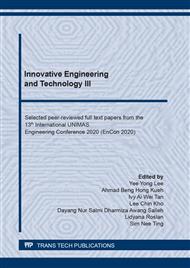[1]
F.J. Kadhim, J.-J. Zheng, F.J.K.J.-J. Zheng, Review of the Factors That Influence on the Microbial Induced Calcite Precipitation, Civ. Environ. Res. 8 (2016) 69–76.
Google Scholar
[2]
M. Umar, K.A. Kassim, K.T. Ping Chiet, K.T.P. Chiet, Biological process of soil improvement in civil engineering: A review, J. Rock Mech. Geotech. Eng. 8 (2016) 767–774.
DOI: 10.1016/j.jrmge.2016.02.004
Google Scholar
[3]
S.S. Park, S.G. Choi, I.H. Nam, Effect of plant-induced calcite precipitation on the strength of sand, J. Mater. Civ. Eng. 26 (2014) 1–5.
DOI: 10.1061/(asce)mt.1943-5533.0001029
Google Scholar
[4]
H. Tung, J. Alleman, B. Cetin, S. Choi, Engineering Properties of Biocementation Coarse- and Fine-Grained Sand Catalyzed By Bacterial Cells and Bacterial Enzyme, J. Mater. Civ. Eng. 32 (2020) 1–15.
DOI: 10.1061/(asce)mt.1943-5533.0003083
Google Scholar
[5]
A. Nafisi, S.M. Asce, B.M. Montoya, M. Asce, T.M. Evans, A.M. Asce, Shear Strength Envelopes of Biocemented Sands with Varying Particle Size and Cementation Level, 146 (2020) 1–14.
DOI: 10.1061/(asce)gt.1943-5606.0002201
Google Scholar
[6]
H.T.P. Kong, K.A. Kassim, M. Umar, M. Uba Zango, A.S. Muhammed, K. Ahmad, Microbially induced carbonate precipitations to improve residual soil at various temperatures, Bull. Geol. Soc. Malaysia. 67 (2019) 75–81.
DOI: 10.7186/bgsm67201909
Google Scholar
[7]
M.U. Zango, K.A. Kassim, A.S. Muhammed, K. Ahmad, Effect of Bio-calcification on the Shear Strength of Compacted Clay Liner, Test Eng. Manag. (2020) 11696–11702.
Google Scholar
[8]
M. Lee, M.G. Gomez, A.C.M. San Pablo, C.M. Kolbus, C.M.R. Graddy, J.T. DeJong, D.C. Nelson, Investigating Ammonium By-product Removal for Ureolytic Bio-cementation Using Meter-scale Experiments, Sci. Rep. 9 (2019) 18313.
DOI: 10.1038/s41598-019-54666-1
Google Scholar
[9]
Z. Zhao, N. Hamdan, L. Shen, H. Nan, A. Almajed, E. Kavazanjian, X. He, Biomimetic hydrogel composites for soil stabilization and contaminant mitigation, Environ. Sci. Technol. 50 (2016) 12401–12410.
DOI: 10.1021/acs.est.6b01285
Google Scholar
[10]
H.W. Paerl, N. Carolina, Coastal eutrophication and harmful algal blooms : Importance of atmospheric deposition and groundwater as new , nitrogen and other nutrient sources, 42 (1997).
DOI: 10.4319/lo.1997.42.5_part_2.1154
Google Scholar
[11]
L. Minyong, K. Colin M., A.D. Yepez;, G. Michael G., Investigating Ammonium By-Product Removal following Stimulated Ureolytic Microbially-Induced Calcite Precipitation, in: Geo-Congress 2019, 2019: p.260–272.
DOI: 10.1061/9780784482117.026
Google Scholar
[12]
S.P. Alexandra C. M., L. Minyong, G. Charles M. R., K. Colin M., M. Khan, A. Zamani, N. Martin, C. Acuff, M.G. Gomez, Examining Spatial Control, Ammonium By-Product Removal, and Chemical Reductions for Bio-Cementation Soil Improvement Using Meter-Scale Experiments, in: Geo-Congress 2020 GSP 315, 2020: p.458–468.
DOI: 10.1061/9780784482780.044
Google Scholar
[13]
K. Feng, B.M. Montoya, Drained Shear Strength of MICP Sand at Varying Cementation Levels, in: IFCEE 2015 © ASCE 2015, 2015: p.2242–2251.
DOI: 10.1061/9780784479087.208
Google Scholar
[14]
M. Li, C. Fang, S. Kawasaki, V. Achal, Fly ash incorporated with biocement to improve strength of expansive soil, Sci. Rep. 8 (2018) 4–10.
DOI: 10.1038/s41598-018-20921-0
Google Scholar
[15]
N.N. Nik Daud, A.S. Muhammed, M. Nadwatul Khodijah, W.Y. Wan Zuhairi, Attenuation Capacity of Soil Mixed with Palm, J. Teknol. 6 (2016) 99–103.
Google Scholar
[16]
M.K. Manikam, A.A. Halim, M.M. Hanafiah, R.R. Krishnamoorthy, Removal of ammonia nitrogen, nitrate, phosphorus and cod from sewage wastewater using palm oil boiler ash composite adsorbent, Desalin. Water Treat. 149 (2019) 23–30.
DOI: 10.5004/dwt.2019.23842
Google Scholar
[17]
Y. Zhu, P. Kolar, S.B. Shah, J.J. Cheng, P.K. Lim, Avocado seed-derived activated carbon for mitigation of aqueous ammonium, Ind. Crop. Prod. 92 (2016) 34–41.
DOI: 10.1016/j.indcrop.2016.07.016
Google Scholar


